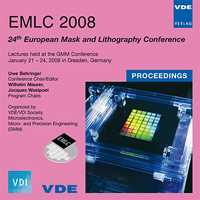Mask CD measurement approach by diffraction intensity for lithography equivalent
Conference: EMLC 2008 - 24th European Mask and Lithography Conference
01/21/2008 - 01/24/2008 at Dresden, Germany
Proceedings: EMLC 2008
Pages: 10Language: englishTyp: PDF
Personal VDE Members are entitled to a 10% discount on this title
Authors:
Nagai, Takaharu; Mesuda, Kei; Sutou, Takanori; Inazuki, Yuichi; Hashimoto, Hiroyuki; Yokoyama, Toshifumi; Toyama, Nobuhito; Morikawa, Yasutaka; Mohri, Hiroshi; Hayashi, Naoya (Electronic Device Operations, Dai Nippon Printing Co., Ltd., 2-2-1, Fukuoka, Fujimino-shi, Saitama 356-8507, Japan)
Abstract:
In 45nm node and beyond with hyper NA lithography, mask topography effect is not ignorable and mask CD bias impacts printing performance such as MEEF or exposure latitude. In that situation, 3D simulation is required for precise evaluation of printing performance and the accuracy of 3D mask model on simulation is a key issue. Verification of 3D mask model by diffraction intensity measurement with AIMS(TM)45-193i was discussed in our previous works. Through the verification, though real mask successfully creates effective or simulated diffractions, CD on 3D mask model on simulation was different to that on AIMS(TM) result which was measured by CD-SEM. Therefore, purpose of this work is to analyze the cause of CD differences through AIMS(TM) diffraction intensity evaluation in various conditions (mask material, pattern pitch, mask CD bias and mask CD-SEM system). Furthermore, lithography equivalent CD is proposed as width of “ideal” mask shape. As a result achieved from the experiments, constant CD shift was successfully observed at hp40-70nm L/S pattern with varied bias for both 6% EAPSM and Binary masks. It can be said that mask topography difference related to mask material and pattern dimensions has not been observed. On the other hand, the value of CD shift was smaller on the condition of newer generation CD-SEM measurement. Other result achieved from further discussion and analysis, cause of the CD difference was explained using simple SEM image simulation. The CD difference was mainly changed by electron beam size factor, and it was stable with side wall angle in the range of 80 to 90degree if the middle CD, which is the width of 3D model defined at the half height of the mask film’s thickness, is constant. Since side wall angles on actual masks are nearly 90degree, lithography equivalent CD could be measured by CD-SEM with constant offset.


